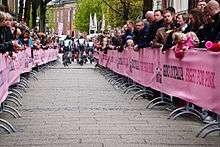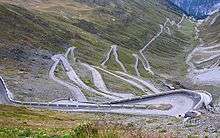2012 Giro d'Italia
The 2012 Giro d'Italia was the 95th edition of Giro d'Italia, one of cycling's Grand Tours. It started in the Danish city of Herning,[1] and ended in Milan. The complete route of the 2012 Giro d'Italia was announced in mid October. For the first time since the 2007 edition no climbing time trial was included in the route. The colour of the jersey for the mountains classification was changed for this year's edition from green to blue. The move came at the behest of sponsor Banca Mediolanum, who renewed its support of the mountains classification for a further four years.[2]
| 2012 UCI World Tour, race 15 of 28 | |||||||||||||||||||||||||||||||||||||
|---|---|---|---|---|---|---|---|---|---|---|---|---|---|---|---|---|---|---|---|---|---|---|---|---|---|---|---|---|---|---|---|---|---|---|---|---|---|
 | |||||||||||||||||||||||||||||||||||||
| Race details | |||||||||||||||||||||||||||||||||||||
| Dates | 5–27 May | ||||||||||||||||||||||||||||||||||||
| Stages | 21 | ||||||||||||||||||||||||||||||||||||
| Distance | 3,502.1 km (2,176 mi) | ||||||||||||||||||||||||||||||||||||
| Winning time | 91h 39' 02" | ||||||||||||||||||||||||||||||||||||
| Results | |||||||||||||||||||||||||||||||||||||
| |||||||||||||||||||||||||||||||||||||
The race was won by Canada's Ryder Hesjedal of Garmin–Barracuda,[3] becoming the first Canadian rider to win a Grand Tour event and the second non-European rider to win the Giro (the first being Andrew Hampsten in 1988); he also became only the second rider to take the leader's jersey from another rider on the final day, after Francesco Moser did so in 1984.[4] Hesjedal won the general classification by 16 seconds over runner-up Joaquim Rodríguez of Spain, representing Team Katusha – the closest race-winning margin since Eddy Merckx beat Gianbattista Baronchelli by 12 seconds in the 1974 edition[5] – who also won two stages and the points classification title,[6] edging out Team Sky sprinter Mark Cavendish by one point. Third place was taken by Vacansoleil–DCM's Thomas De Gendt of Belgium, after he put in strong performances on the final two stages of the race; he won the race's queen stage, finishing at the high-point of the itinerary, at the Stelvio Pass and also finished in the top five of the time trial.[7] As such, he gained sufficient time to move up from ninth to third over those stages, becoming the first Belgian rider to take a Grand Tour podium since Johan Bruyneel finished third at the 1995 Vuelta a España.[8]
In the race's other classifications, Team Sky rider Rigoberto Urán of Colombia finished as the best rider aged 25 or under in the general classification,[9] finishing in seventh place overall; the mountains competition was won by Italy's Matteo Rabottini of the Farnese Vini–Selle Italia team, scoring almost double the number of points that his nearest rival in the standings accrued. Rabottini was the only Italian to feature on the podium, as for the first time since 1995,[10] no Italian riders finished in the top three overall, as Lampre–ISD's Michele Scarponi – the defending champion – could only finish fourth overall.
Teams

All 18 UCI ProTeams were automatically invited and were obliged to attend. In addition four UCI Professional Continental were announced in January 2012.[11] The full list of participating teams is:
|
|
| |
|
|
Pre-race favourites
2011 winner Alberto Contador was banned for two years on 6 February for doping during 2010 Tour de France and therefore did not start in the Giro. Ivan Basso, winner of the Giro of 2006 and 2010, announced on 13 November 2011 that he was aiming for a third pink jersey.[12]
Johan Bruyneel, manager of the new fusion team between Leopard-Trek and Team Radioshack, stated that it would be hard for three-time runner-up Andy Schleck and his brother Fränk Schleck to win the 2012 Tour de France because of the large number of kilometers against the clock. There was a chance that one of the brothers would target the Giro d'Italia instead.[13] On 19 November 2011 Fränk initially announced that the Schleck brothers would not ride the Giro and will focus on the Tour despite the time trialing kilometers.[14] Eventually on 29 April 2012 it was announced that Fränk Schleck would replace the injured Jakob Fuglsang as the team leader during the race.[15]
On 17 April Michele Scarponi, winner of the 2011 edition after Contador's suspension, announced that he wanted to win the Giro on the road and not after a suspension of another rider.[16] Scarponi teamed-up with Lampre-ISD teammate and 2004 Giro d'Italia winner Damiano Cunego. Cunego aimed for a high finish in the Giro and skipped the 2012 Tour de France due to the large amount of time trialing kilometers.[17]
Other riders named as overall contenders were Ag2r-La Mondiale's John Gadret (third overall in the 2011 Giro d'Italia), 2011 Youth classification winner Roman Kreuziger of team Astana, Team Katusha's Joaquim Rodríguez (fourth overall in the 2011 Giro d'Italia) and the Venezuelan climber José Rujano of the Androni Giocattoli team.
Route and stages
The first three stages were announced on 5 October 2011, with the remaining stages announced on 16 October.[18][19] On 18 April 2012 it was announced that the route for Stage 12 Seravezza to Sestri Levante had been altered because the coastal road through the Cinque Terre remains unusable following the severe landslides which struck the area on 25 October 2011. The new route is 155 km (96 mi) long.[20]
The stages were divided into five categories of difficulty; category A, B for flat stages (from A for "stages presenting no particular difficulty"), category C for medium mountain stage, category D for mountain stages and category E for time trial stages. These categories were used to determine the time limit on the stage.[21]
| Stage | Date[21] | Course | Distance | Type | Winner | ||
|---|---|---|---|---|---|---|---|
| 1 | 5 May | Herning (Denmark) | 8.7 km (5.4 mi) | Individual time trial | |||
| 2 | 6 May | Herning (Denmark) | 206 km (128 mi) | Flat stage | |||
| 3 | 7 May | Horsens (Denmark) | 190 km (118 mi) | Flat stage | |||
| 8 May | Rest day | ||||||
| 4 | 9 May | Verona | 33.2 km (20.6 mi) | Team time trial | Garmin–Barracuda | ||
| 5 | 10 May | Modena to Fano | 209 km (130 mi) | Flat stage | |||
| 6 | 11 May | Urbino to Porto Sant'Elpidio | 210 km (130 mi) | Medium mountain stage | |||
| 7 | 12 May | Recanati to Rocca di Cambio | 205 km (127 mi) | Medium mountain stage | |||
| 8 | 13 May | Sulmona to Lago Laceno | 229 km (142 mi) | Medium mountain stage | |||
| 9 | 14 May | San Giorgio del Sannio to Frosinone | 166 km (103 mi) | Flat stage | |||
| 10 | 15 May | Civitavecchia to Assisi | 186 km (116 mi) | Hilly stage | |||
| 11 | 16 May | Assisi to Montecatini Terme | 255 km (158 mi) | Hilly stage | |||
| 12 | 17 May | Seravezza to Sestri Levante | 155 km (96 mi) | Medium mountain stage | |||
| 13 | 18 May | Savona to Cervere | 121 km (75 mi) | Flat stage | |||
| 14 | 19 May | Cherasco to Cervinia | 206 km (128 mi) | Mountain stage | |||
| 15 | 20 May | Busto Arsizio to Lecco-Pian dei Resinelli | 169 km (105 mi) | Mountain stage | |||
| 21 May | Rest day | ||||||
| 16 | 22 May | Limone sul Garda to Pfalzen | 173 km (107 mi) | Hilly stage | |||
| 17 | 23 May | Pfalzen to Cortina d'Ampezzo | 186 km (116 mi) | Mountain stage | |||
| 18 | 24 May | San Vito di Cadore to Vedelago | 149 km (93 mi) | Flat stage | |||
| 19 | 25 May | Treviso to Alpe di Pampeago | 198 km (123 mi) | Mountain stage | |||
| 20 | 26 May | Caldes-Val di Sole to Passo dello Stelvio | 219 km (136 mi) | Mountain stage | |||
| 21 | 27 May | Milan | 28.2 km (17.5 mi)[22] | Individual time trial | |||
Classification leadership
In the 2012 Giro d'Italia, four different jerseys were awarded. For the general classification, calculated by adding each cyclist's finishing times on each stage, and allowing time bonuses for the first three finishers on mass-start stages, the leader received a pink jersey. This classification was considered the most important of the Giro d'Italia, and the winner was considered the winner of the Giro.[23]

Additionally, there was a points classification, which awarded a red jersey. In the points classification, cyclists got points for finishing in the top 15 in a stage. Unlike in the better known points classification in the Tour de France, the type of stage had no effect on what points were on offer – each stage had the same points available on the same scale. The win earned 25 points, second place earned 20 points, third 16, fourth 14, fifth 12, sixth 10, and one point fewer per place down to a single point for 15th. In addition, points could be won in intermediate sprints.[23]
There was also a mountains classification, the leadership of which was marked by a blue jersey. The jersey had been green since the jersey was first awarded, but with a sponsorship change, the jersey color was changed to blue. In the mountains classifications, points were won by reaching the top of a climb before other cyclists. Each climb was categorized as either first, second, third, or fourth-category, with more points available for the higher-categorized climbs. The Cima Coppi, the race's highest point of elevation, awarded still more points than the other first-category climbs.[23] The Cima Coppi for the 2012 Giro d'Italia was the Passo dello Stelvio. The first rider to cross the Stelvio was Thomas De Gendt.
The fourth jersey represented the young rider classification, marked by a white jersey. This was decided the same way as the general classification, but only riders born after 1 January 1987 were eligible.[23]
There were also two classifications for teams. In the Trofeo Fast Team classification, the times of the best three cyclists per team on each stage were added; the leading team was the team with the lowest total time; the Trofeo Super Team was a team points classification, with the top 20 placed riders on each stage earning points (20 for first place, 19 for second place and so on, down to a single point for 20th) for their team.[23]
The rows in the following table correspond to the jerseys awarded after that stage was run.
Final standings
| Legend | |||
|---|---|---|---|
| |
Denotes the winner of the General classification | |
Denotes the winner of the Mountains classification |
| |
Denotes the winner of the Points classification | |
Denotes the winner of the Young rider classification |